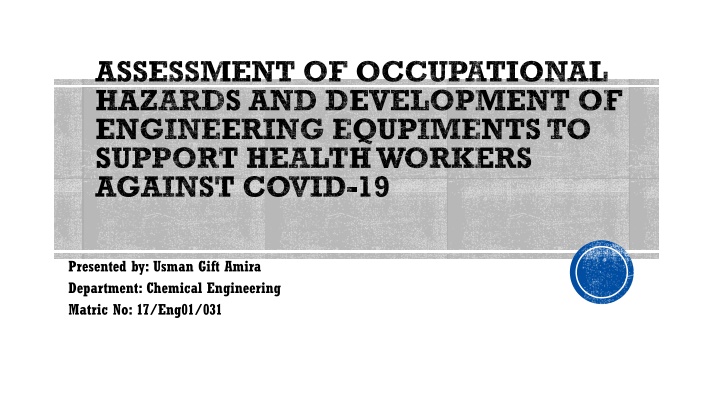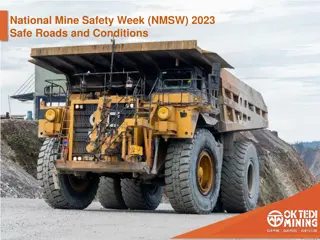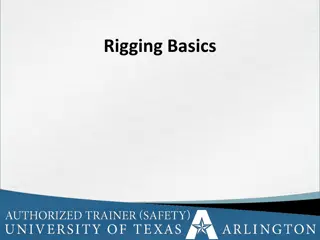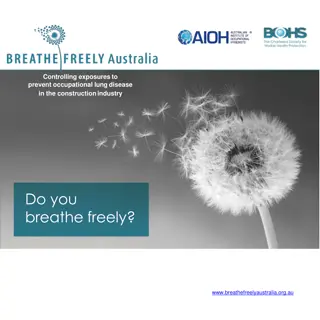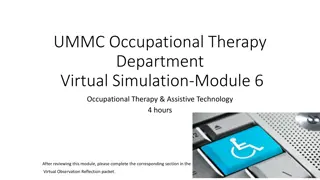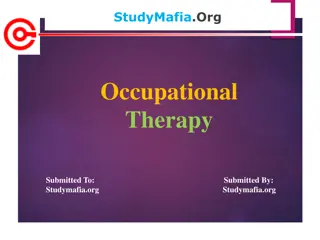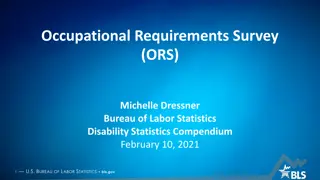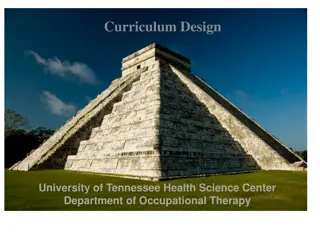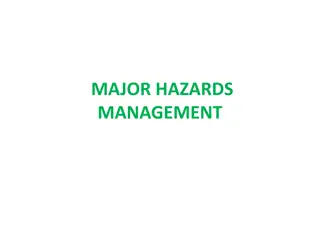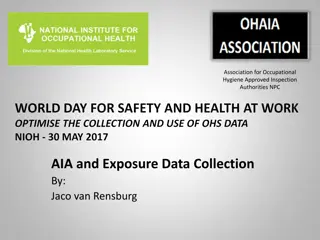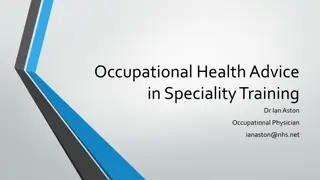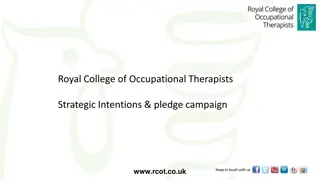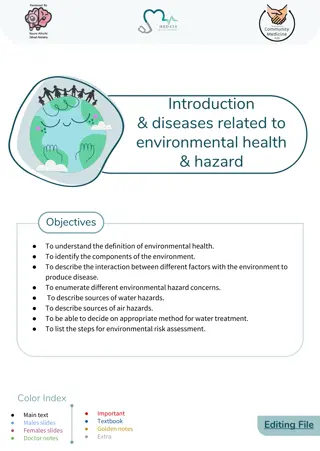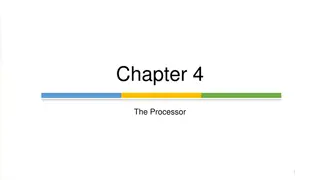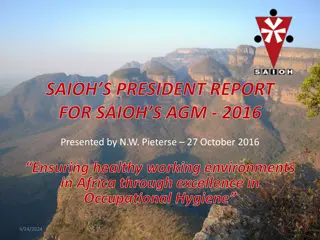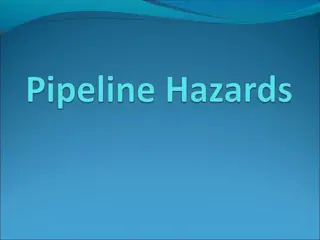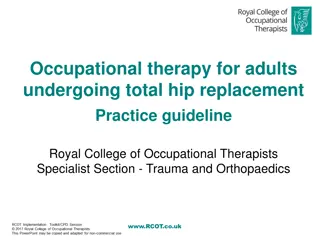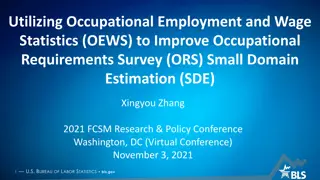Assessment of Occupational Hazards in Battling COVID-19
The assessment of occupational hazards and development of engineering equipment to support health workers against COVID-19 is crucial for ensuring safety and continuity in the face of the ongoing pandemic. This involves understanding the risks posed by the virus, implementing proactive measures, and developing equipment to safeguard the well-being of frontline workers. Explore the challenges and strategies in combating COVID-19 hazards effectively.
Download Presentation

Please find below an Image/Link to download the presentation.
The content on the website is provided AS IS for your information and personal use only. It may not be sold, licensed, or shared on other websites without obtaining consent from the author.If you encounter any issues during the download, it is possible that the publisher has removed the file from their server.
You are allowed to download the files provided on this website for personal or commercial use, subject to the condition that they are used lawfully. All files are the property of their respective owners.
The content on the website is provided AS IS for your information and personal use only. It may not be sold, licensed, or shared on other websites without obtaining consent from the author.
E N D
Presentation Transcript
ASSESSMENT OF OCCUPATIONAL HAZARDS AND DEVELOPMENT OF ENGINEERING EQUPIMENTS TO SUPPORT HEALTH WORKERS AGAINST COVID-19 Presented by: Usman Gift Amira Department: Chemical Engineering Matric No: 17/Eng01/031
ABSTRACT The world today as we know it has been combating hazards and accidents on different levels for the safety and continuity of mankind. We see this battle basically in industrials and factories where production is the activity that takes place and where these hazards are most common. Outside the industries, there are provisions for the education of the masses of the hazard that lurk about our environment and also on our health and personal hygiene. All around the world, this battle against hazards and accidents is depicted in form of guidelines and proactive measures set by safety personnel after assessment of risks that is accompanied with any near miss, hazard or accident. Today, we battle a pandemic that ravages the surface of the earth, claiming lives and although measures have been put in place to prevent the spread of the deadly disease, there is still no cure for it. What we face out there is a true battle for our lives between we humans and not just hazards and accidents, but also near miss, diseases, violence and anything threatening to our lives and our health. 2
INTRODUCTION CORONA VIRUS Corona disease 2019 (COVID-19) is an infectious disease caused by severe acute respiratory syndrome coronavirus 2 (SARS-CoV-2). The disease was first identified in December 2019 in Wuhan, the capital of China's Hubei province, and has since spread globally, resulting in the ongoing 2019 20 coronavirus pandemic. Common symptoms include fever, cough and shortness of breath. Other symptoms may include fatigue, muscle pain, diarrhea, sore throat, loss of smell and abdominal pain. The time from exposure to onset of symptoms is typically around five days, but may range from two to 14 days. While the majority of cases result in mild symptoms, some progress to viral pneumonia and multi-organ failure. As of 9 April 2020, more than 1.5 million cases have been reported in more than 200 countries and territories, resulting in more than 90,000 deaths. More than 340,000 people have recovered. 3
CORONA VIRUS The virus is mainly spread between people during close contact, often via small droplets produced during cough, sneeze, or talk. While these droplets are produced when breathing out, they usually fall to the ground or surfaces rather than being infectious in the air over large distances. People may also become infected by touching a contaminated surface and then their face. The virus can survive on surfaces for up to 72 hours. Coronavirus is most contagious during the first three days after onset of symptoms, although spread may be possible before symptoms appear and in later stages of the disease. Recommended measures to prevent infection include frequent hand washing, social distancing (maintaining physical distance from others, especially from those with symptoms), covering coughs and sneezes with a tissue or inner elbow and keeping unwashed hands away from the face. The use of masks is recommended for those who suspect they have the virus and their caregivers. Recommendations for mask use by the general public vary, with some authorities recommending against their use, some recommending their use and others requiring their use. Currently, there is no vaccine or specific antiviral treatment for COVID-19. Management involves treatment of symptoms, supportive care, isolation and experimental measures. 4
PREVENTIVE MEASURES AGAINST THE SPREAD OF THE CORONA VIRUS This is a pictorial representation of the measures to be taken when dealing with the corona virus also know as COVID- 19 as established by the World Health Organization (WHO). 5
LITERATURE REVIEW HAZARDS AND OCCUPATIONAL HAZARDS When we refer to hazards in relation to occupational safety and health the most commonly used definition is A Hazard is a potential source of harm or adverse health effect on a person or persons . An occupational hazard is a thing or situation with the potential to harm a worker. Occupational hazards can be divided into two categories: safety hazards that cause accidents that physically injure workers, and health hazards which result in the development of disease. It is important to note that a "hazard" only represents a potential to cause harm. Whether it actually does because harm will depend on circumstances, such as the toxicity of the health hazard, exposure amount, and duration. Hazards can also be rated according to the severity of the harm they cause - a significant hazard being one with the potential to cause a critical injury or death 6
HAZARD AND OCCUPATIONAL HAZARDS The types of hazards are as follows: Chemical Hazards: Chemical hazards are a subtype of occupational hazards that involve dangerous chemicals. Exposure to chemicals in the workplace can cause acute or long-term detrimental health effects. There are many classifications of hazardous chemicals, including neurotoxins, immune agents, dermatologic agents, carcinogens, reproductive toxins, systemic toxins, asthmagens, pneumoconiosis agents, and sensitizers. Biological Hazards: Biological agents, including microorganisms and toxins produced by living organisms, can cause health problems in workers. Influenza is an example of a biohazard which affects a broad population of workers. Those who work outdoors encounter numerous biological hazards, including bites and stings from insects, spiders, snakes and scorpions, contact dermatitis from exposure to urushiol from poisonous Toxicodendron plantsLyme disease. 7
HAZARDS AND OCCUPATIONAL HAZARDS Psychosocial Hazards: Psychosocial hazards are occupational hazards that affect someone's social life or psychological health. Psychosocial hazards in the workplace include occupational burnout and occupational stress, which can lead to burnout. Physical Hazards: Physical hazards are a subtype of occupational hazards that involve environmental hazards that can cause harm with or without contact. Physical hazards include ergonomic hazards, radiation, heat and cold stress, vibration hazards, and noise hazards. 8
WHAT ARE ENGINEERING CONTROLS? Engineering controls are the preferred method of controlling exposure to workplace hazards. They can be placed in three categories: Substitution includes the use of a less hazardous material, a change in the process equipment used, or a change in the process itself. Care must be taken to ensure that the substitution actually does result in less hazardous conditions. Isolation is a method of limiting exposure to those employees who are working directly with the hazard, often by enclosing them within a containment structure. While isolation will reduce the risk to those outside the isolated area, it should be accompanied by appropriate controls to ensure that those within are not faced with an increased exposure to the hazard. Ventilation is most important for the control of airborne hazards. It involves the removal (from the workplace) of air that contains a hazardous contaminant and its replacement with uncontaminated outside air. There are two types: local exhaust and general dilution. A properly designed local exhaust system can capture a contaminant where it is generated and remove it before it is dispersed into the work environment. 9
THE HIERARCHY OF CONTROL MEASURES Control measures include actions that can be taken to reduce the potential of exposure to the hazard, or the control measure could be to remove the hazard or to reduce the likelihood of the risk of the exposure to that hazard being realized. A simple control measure would be the secure guarding of moving parts of machinery eliminating the potential for contact. When we look at control measures we often refer to the hierarchy of control measures. 10
DEVELOPMENT OF ENGINEERING EQUIPMENT TO SUPPORT HEALTH WORKERS ON CURBING COVID-19 Engineers in China have developed a robot to treat and test Covid-19 patients while allowing healthcare workers to remain at a safe distance from the highly infectious virus. The remote-controlled, wheeled machine can take mouth swabs, perform ultrasound scans and listen to organs with a robot stethoscope. Medical staff can operate the robots from a safe distance using on-board cameras to monitor the patient. High infection rates among health care workers have hampered efforts to tackle the outbreak, prompting the designers to see if a robot could provide protection. Robot engineers have long promised their machines will eventually save human workers from dull, dangerous or dirty work. The coronavirus epidemic presents an opportunity to tests what robots may be able to do, some scientists believe. "Doctors are all very brave," the robot's chief designer, Tsinghua University Professor Zheng Gangtie told Reuters. "But this virus is just too contagious ... We can use robots to perform the most dangerous tasks." Prof Zheng said the idea came as he watched the Chinese city of Wuhan go on lockdown earlier in the year as the number of cases in China rose rapidly. He said a friend, Dong Jiahong, executive president at Beijing's Tsinghua Changgung Hospital, had told him one of the biggest challenges was frontline workers getting infected. 11
DEVELOPMENT OF ENGINEERING EQUIPMENT TO SUPPORT HEALTH WORKERS ON CURBING COVID-19 Gathering a team, he converted two robotic arms such as those used on space stations or lunar explorers. The robots were almost entirely automated, and could even disinfect themselves after performing actions involving contact, he said. Yet the robots may have disconcerted patients, according to the first medical reports. "The feedback from doctors was that it would be better for there to be less automation, as a personal presence would comfort and calm the patient," he said. Prof Zheng said he would like to build more such robots but funding from the university has run out. The robots cost around 62,000 each to build. He said he did not plan on commercialising his robot design but hopes a company comes along to take that on. Meanwhile Spain, which has one of the world's worst outbreaks, said at the weekend that it would use robots to increase testing. The country has been testing between 15,000 and 20,000 people a day and will use automation to increase that fourfold. 12
METHODOLOGY CASE STUDY A qualitative study on psychosocial hazards among health care workers in a tertiary health facility in south-south Nigeria A health needs assessment provides the opportunity to gain an awareness of the current health of the workforce and to identify the gaps in healthcare provision, as well as to make recommendations to the organisation (Phillips, 2013). The National Institute for Health and Care Excellence (NICE) defines a health-needs assessment as a systematic method for reviewing the health issues facing a population, leading to agreed priorities that will improve health and reduce inequalities (2005). 13
METHODOLOGY CASE STUDY A cross sectional study was carried out in the University of Port Harcourt Teaching Hospital, Rivers State, Nigeria using qualitative method. Data on the psychosocial hazards were obtained from medical and surgical clinics, medical and surgical wards, theatre, laboratory, radiology and administrative sections of the hospital via key informant interviews. The risk assessment matrix was used to ascertain the risk scores and levels of identified hazards. The scores were summarized using medians and interquartile ranges and the differences in the median scores across the sections were compared using Kruskal Wallis statistics. 14
DATA ANALYSIS RESULTS A total of eighteen subjects were interviewed from the sections of the hospital. Work overload had the highest proportion of all the psychosocial hazards in the theatre (83%), radiology (71%), clinic (52%), ward (42%) and laboratory (38%). Other psychosocial hazards were poor interpersonal relationship, assault from patient relatives and job dissatisfaction/boredom. The differences in the median psychosocial hazard risk scores across the sections were not statistically significant (P=0.915) Statistical tables are provided in the next slide; 15
Psychosocial hazards Work Overload Assault from Patient Relatives Risk score (%) Poor Inter Personal Relationship Risk score (%) Dissatisfaction/ Boredom Total Risk score (%) Risk score (%) Risk score (%) TABLE ONE Sections of the hospital Laboratory Distribution of psychosocial hazards and risk scores across the sections of the hospital 15 (38%) 12 (31%) 12 (31%) 0 (0%) 39 (100%) Radiology 15 (71%) 0 (0%) 6 (29%) 0 (0%) 21 (100%) Clinic 16 (52%) 9 (29%) 6 (19%) 0 (0%) 31 (100%) Theatre 15 (83%) 0 (0%) 3 (17%) 0 (0%) 18 (100%) Ward 15 (42%) 9 (5%) 12 (33%) 0 (0%) 36 (100%) Administrative 0 (0%) 0 (0%) 12 (44%) 15 (56%) 27 (100%) 16
Psychosocial hazard risk ranking scores Sections Median risk score Interquartile range (IQR) Laboratory 12.0 3.0 14.3 TABLE TWO Radiology 3.0 0.0 12.8 Comparison of the psychosocial hazards risk ranking scores across the sections of the hospital Clinic 7.5 1.5 14.3 Theatre 1.5 0.0 12.0 Ward 10.5 2.3 14.3 Administrative 6.0 0.0 14.3 Kruskal Wallis test =1.48; P = 0.915 17
CONCLUSION AND RECOMMENDATION CONCLUSION This study identified high work overload, poor interpersonal relationships, assault by patients relatives and job dissatisfaction as the psychosocial hazards experienced by health care workers. The risk levels of these hazards among health care workers varied from low to extreme. Hence, the need to institute workplace policies aimed at curbing these hazards among workers whose work is primarily to ensure the optimal health of the Nigerian populace. 18
RECOMMENDATION Following the health-needs assessment, the WHO service made the following recommendations: An up-to-date risk assessment should be undertaken by the theatre manager, particularly with regard to equipment used. Any necessary modifications should be carried out immediately. All employees should attend the mandatory manual handling training and subsequent yearly updates and a departmental record should be kept of attendance at such training, with a recall system so that attendance will rise from 50% to 100%. All employees who have sustained an injury at work should be referred to OH within 24 hours of the reported injury, and all musculoskeletal conditions should be advised of the health and wellbeing service in order to access early assessment and treatment. All health board employees should have an increased awareness of the role of OH and the services it offers. An evaluation should be undertaken in five months to monitor the effectiveness of the equipment modifications and advised interventions. 19
REFERENCES Black C (2012). Why healthcare organisations must look after their staff . Nursing Management; vol.19, issue 6, pp.27-30. CIPD (2013). Absence management 2013: Annual survey report. Fabrizo P (2009). Ergonomic intervention in the treatment of a patient with upper extremity and neck pain . Physical Therapy; vol.8, issue 4, pp.351-360. Health and Safety Executive (2014). Management of health and safety at work. Health and Safety Executive (2011). Manual handling at work: A brief guide. Health and Safety Executive (2013). Health and Safety (sharps instruments in healthcare) Regulations 2013: Guidance for employers and employees. Ndejjo R, Musinguzi G, Yu X, et al. Occupational Health Hazards among Healthcare Workers in Kampala, Uganda. J Env Public Health 2015:1 9. European Agency for Safety and Health at Work. Risk assessment in health care. 2016;1 8. Asuzu MC. Occupational Hazards. Principles and Practice of Occupational Health 2nd Ed. Ibadan; Afrik Publishers. 2002;6. 20
THANK YOU 21 Name: Usman Gift Amira Department: Chemical Engineering Matric No: 17/Eng01/031
